Stamp 0 – 1907? |
This stamp is not an anomaly. The 1907 Dodge Catalog shows this stamp (albeit upside down) without any English letters. According to my friend +Aziz, the top word looks like ‘Kurwah’ or ‘Kurwiyah’—the root of the word is Kurah or كرة which means “ball” – Ottoman-Turkish was limited in it’s vowels, and had multiple symbols for the letter ‘z’ (see here). The stamp is Ottoman-Turkish for the name “Kerope Zildjian”. These stamps are often incomplete. Here is another Stamp 0 that shows more of the bottom right part of the stamp: STAMP 0. |
Stamp 1 – 1913? |
I think this is the actual first stamp because it lacks many of the later elements, and there are many very old looking cymbals out there with this combination of stamp elements. This one was also stamped “C.D.” next to the stamp. It is 12 inches in diameter, thick, and was described as “before the 1920s” by there person who shared it with me. A commenter below says the stamp appears on a cymbal purchased before 1913. In any case this stamp lacks the moon & star, as well as the word “TRADEMARK” from later stamps. The earliest cymbals also had a distinct signature under the bell that oftentimes said “K Zildjian & Cie”. See comment 17 below. |
Stamp 2 |
This stamps uses a different Arabic element, and incorporates the word “Trademark” underneath the other stamp elements. Perhaps it was a stamping error (?) but it is missing the crescent and star seen in later stamps. Thanks to Scott Gordon of Carmichael, California for this stamp photo |
Stamp 3 |
This seems to be the smallest star and crescent of any of the stamps out there.
My friend +Aziz tells me that one of the words in the Turkish/Arabic “definitely says ‘Sharikat’ which means ‘company’.” Thanks, +Aziz… any other help with translations would be useful. I presume he’s referring to the ” شر ” which would be ‘Shar’ in the bottom right corner, followed with ” قت ” which would be ‘qat’ to the left. Also, these cymbals can rarely be found with the original sticker labels (see: right). |
Stamp 3 |
Stamp 4 |
This one appears to have the thin crescent and star that were used in the early Istanbul stamps. It is likely the final Constantinople stamp before they switched over to stamps that label the city as ‘Istanbul’. |
Below, there are more images of what I’m calling Stamp 1 (far left), this one shows the different parts of the Arabic text. This stamp is often incomplete. If someone has better ideas about the Constantinople stamps, feel free to let me know. I’m just calling them “stamp 1, 2, 3” according to my judgement. There must be one before this that used no stamp but I’ve never heard of one.
In Stamp 4 (far right), notice how the word “IN” is short in the phrase “MADE IN TURKEY”.
Also, the earlier cymbals to the left are heavy, almost sounding like a bell when struck. The “stamp 5″ on the right was a 16” cymbal weighing 855 grams (paper thin).
Stamp 1 |
Stamp 2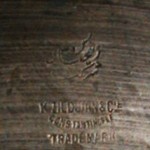 |
Stamp 3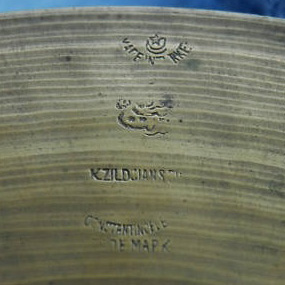 |
Stamp 4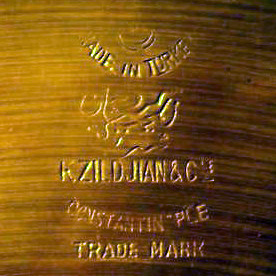 |
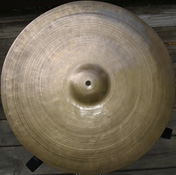 |
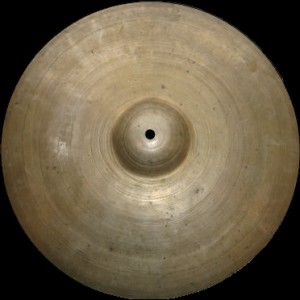 |
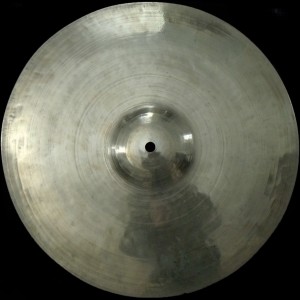 |
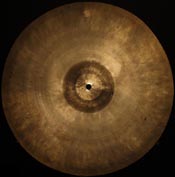 |
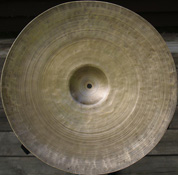 |
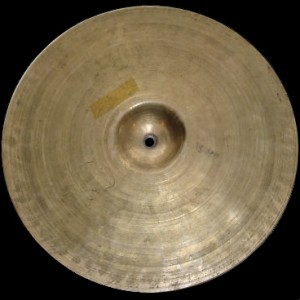 |
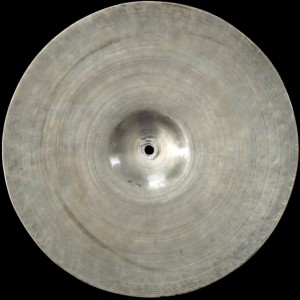 |
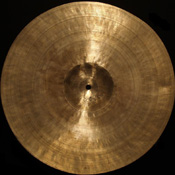 |
Thanks to Richard Reina for sending the images of the “Stamp 3.” There is little to be learned from the above photos, except that the bell size was very small for some of the Constantinople era cymbals, and they were not perfectly round. The different colors of the cymbals are irrelevant: the cymbals were stored in different environments, and were polished at different times. It is similar to how coins change color—the color of a penny or a peso has nothing to do with the way the coin is made. Photography affects the appearance of color, too. The sizes of the cymbals carry little significance: before the 1940s, no cymbals were larger than 15″ or 16″ diameter.

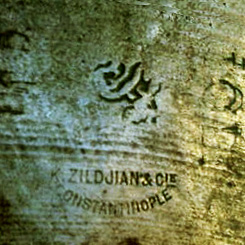
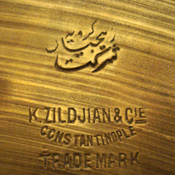
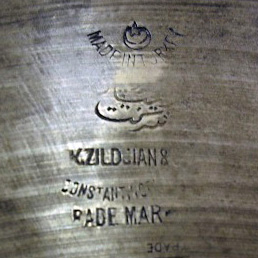
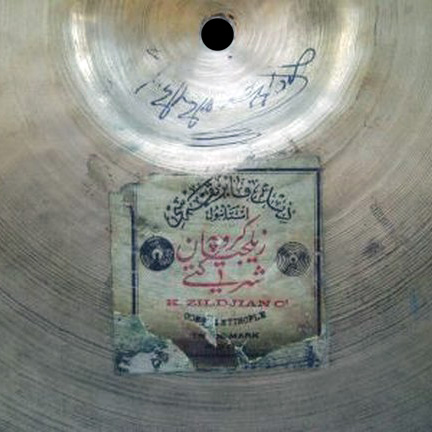

I have a cymbal with the stamp like the one in item 1. Only exception is that there is no CD to the right. It has the Arabic phrase, “K Zildjian & Cie” and “Constantinople”. We have proof that this cymbal was used in a band by my husband’s great-grandfather and great-great-grandfather. We have documentation of their band/orchestra playing in 1913. We want to sell and was wondering who would buy this thing and for how much.
Hello. I have a cymbal with stamp 1. she’s in 15″ and a quarter.unfortunately with a lot of holes for rivets…I would know what maybe is the value for this piece.
mattia
After an interesting email exchange with Mattia, I’m just going to say that I think that old heavy cymbals are under-valued. Before the 1930s no one was using a pair of 15″ outside of the orchestral pit, and they were heavy. Today, the same cymbals are often used as hi-hat cymbals and they sound great. Of course, they all sound different, which is what really matters to a player.
Grazie per le tue foti Mattia—qual tipo di piatto ride si usa? Anche, vorrei aiutarmi con la sezione “Italian (UFIP) Cymbals”? Ciao…
I’m totally with you Rob! The first cymbal used as a main ride for swing(in fact no yet called ride!) was surely an orchestral cymbal made in pair.In that moment (1930 circa) the first cymbals thought and made for riding on his body with a stick were heavy ’cause nobody thought about a thin cymbal yet.
The Avedis Zildjian company was the first that made a thin ride,only under request of Gene Krupa around 1933\35 if I’m not in fail.
About my cymbal,I’ll never sell her because she works so good in couple with K istanbul that I use as a top.I use a new Mehmet Nostalgia ’70 in 22″ as a main ride,so old K’s sound,and another Nostalgia but ’50 model in 20″ on the left. Unfortunately I can’t help you about UFIP because I never had one.(the quality is little bit minor that the Others usually!)
Thank you so much my friend!
I just found this site today. Great information! I’ve been “cleaning up” at home, and have rediscovered the K Zildjian Constantinople Made in Turkey cymbals I own.
In 1971, I bought my first “real” drumset (used) from a neighbor. He threw in all his cymbals, including 2 sets of A hi-hats, plus the K’s. The K’s are 14″; actually, remeasuring them, one is 13 5/8″ and the other is 14″. I have not yet weighed them, but I would describe them as medium-thin.
The K’s both had small cracks at the center hole. My father, who was a machinist, drilled small holes to stop the cracks, which never got bigger. I’ve played the cymbals on and off since owning them. For the rock music I’ve mostly played, I’ve preferred the A’s. But I have never heard any cymbals, old or new, that sound as rich and as dark as these 2 K’s.
I’m charmed to see that this website is useful to so many people. I have a lot of material I will be adding this year, and would gladly appreciate help in figuring out some of the mysteries surrounding these old cymbals.
Richard, I would say that you have a “Stamp 3” from above—with the smallest crescent moon and a tall IN from MADE IN TURKEY. Your second cymbal looks like a “Stamp 5” to me, the short IN from MADE IN TURKEY being the key characteristic.
Bell hole cracks are unfortunate. They are a consequence of the bronze shrinking over time. Often, if the holes are treated carefully, they will not spread. People sometimes install a metal grommets in the hole to avoid bell hole damage.
I have a 14″ highhat K. Zildjian & Cie cymbol with the stamp, very similiar to stamp 2, stating Constantinople without the moon and star from my grandfather who played in the Big Bands from the 30’s & 40’s. The bell hole is not cracked. Not sure of the weight but feels fairly heavy. Just wondering what the date may be on this & what it could be worth.
Chris, the cymbal labelled “Stamp 1” above also includes the word “Constantinople” – the distinguishing trait for “Stamp 2” is the word “Trademark” at the bottom of the stamp. Either way, your cymbal is probably almost 100 years old. The price of the cymbal increases if the cymbal is (1) free of cracks or damage, (2) light weight, and (3) has the original signature under the bell and original patina (i.e. was never cleaned). In any case, isn’t going to sell for more than $100 or so if it is cracked and/or heavy.
Also, the only thing that matters to a player is the sound which is priceless.
I sent you a few pics of the old girl in question, hope they help. Is there a way to upload a photo or two on here so others can see? Any thoughts? Thanks.
I have a 14″ K Zildian Constantinople with the exact stamp shown on the 1913 photos shown. Do you know the estimated value for this cymbal?
This is a really interesting article. As a Zildjian cymbal retailer, I think a good few of our customers would be keen to have a look at your site. Many customers ask us about the heritage of older cymbals, so I will point them to your webpage if they are interested.
Thanks very much, regards Alan
Alan, I’m sorry to say that this is not a Zildjian cymbal. It is an Italian cymbal that was stamped with the word “Constantinople” because the best cymbals were thought to be from Istanbul/Constantinople. I would guess it is from the 1940s. Cymbals with this stamp often had the word “Zveltiam” stamped above the pseudo-arabic, along with a star and moon.
Some hints: the hammering looks a lot like other Italian cymbals from this era such as Zenjian, and the stamp is “upside down” with respect to the edge compared to Zildjians.
It still could be a good cymbal! Matita, an Italian man who posted comments on this webpage, made a youtube of an 18″ Zveltiam here:
http://www.youtube.com/watch?v=iHzLKB8zgOI
Thanks for these images. Indeed, your Stamp #2 is more clear than the one I had earlier. I have substituted your image (above) and credited you for the photo!
Hi folks, what an interesting site.. i have unearthed a cymbal from my collection that has a marking identical to pic 3.. in really great condition..It bears the same marks as the pic on top side and underside has the following…. paper label with zildjian info, also penned on the underside is..15”, K 491, and a signature of some sort within the bell area..Can anyone give me any confirmation of manufacture date and approx value if i decide to sell. It appears to weigh approx 1450 gms,
Some “Stamp 1” type cymbals include the phrase “K Zildjian and Cie – Constantinople” on the other side of the bell from the signature. These were hand-written almost 100 years ago so they are usually wiped off. Still, a few examples remain. Yes, these are possibly signed by Kerope Zildjian himself!
Nick, this cymbal is an anomaly in my book.
The star & moon looks like Stamp 3,
the K. Zildjian & Cie. looks like Old Stamp Istanbul,
the Constantinople looks narrow like Stamp 2,
the Trademark contains a the space bar like Stamp 3 and 4.
It is probably a 1930s export in a bulky order to some company or country. When the Zildjian company stamped it, they used a bunch of old casts to put together the stamp. When the company (or military) received the cymbal “F” was then added later.
Nice site. I have a 21 1/2″ 2180 gram Istanbul with signature under the bell and a stamp I can not find. There is no “Trademark” or “Zildjian” stamp under Istanbul. Star inside the moon. The “O” on Co is underlined. A small “in” and no Costantinople. I’m thinking late 60’s or very early 70’s. This cymbal is so balanced and has even sound around the entire surface and bell. Just a slight 3/8″ crack at the hole.
Thanks, Ron
Ron, It’s a “new” new stamp (1972 – 1977)
http://robscott.net/cymbals/?p=69
Many of these comments are rather blatantly not about the ‘Constantinople’ stamps on this page, I may remove to the Istanbul pages at some point.
Is this a rare dimension? How old do you estimate it and price?
Cheers,
Chet
http://www.drummagazine.com/gear/post/the-romanian-a-zildjians-missing-link/